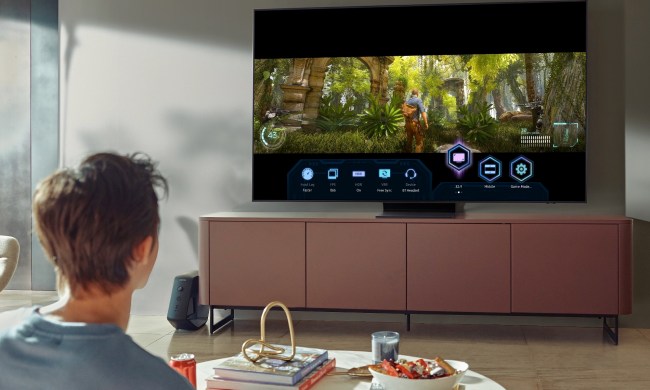“...don't expect an entertainment experience that's always rich and pleasant.”
- Works fine with Media Center; small and unobtrusive
- Few supported formats; lacks digital audio; stuttering issues; trouble handling HD media
Summary
In the vast swirling ocean of digital media, getting your files out of the office and into the living room is often a chore. Apple tried heroically with the Apple TV, but it’s certainly not as popular as the iPhone or the iPod – or even as the Mac itself. Now Samsung is getting into the game with the MediaLive, a device that works with Windows Media Center PCs and supports dual-band Wi-Fi (over 802.11n in both the 2.4GHz and 5.0GHz bands). Be advised, though: While you’re going to need a lot of popcorn with extra butter for this one, don’t expect an entertainment experience that’s always rich and pleasant.
Features and Design
Truth be told, consumers are just not sure about media streaming – the process of transferring audio and video from PC to HDTV or home theater component across a home network. Companies such as Apple, Vudu, and Roku Labs keep trying, however, all with slightly different approaches. The Samsung MediaLive has sided with Microsoft, supporting the extender technology that is thankfully locked into a few standardized formats (such as Windows Media for video), but also woefully confusing since so much of our digital life is not standardized.
Here’s the bottom line: The Samsung MediaLive is lost in a digital soup. Today, the typical media library consists of iTunes-purchased music; CinemaNow downloads; streams from Rhapsody.com or Pandora; ripped music; DVDs you own; BitTorrent files that are not actually legal (ahem); photos in oddball formats (e.g. the increasingly common RAW format); and a hodgepodge of media from many different sources in multiple sizes and resolutions. All of which are, even more dauntingly, stored on USB drives, hard disks, and who knows where else. And despite making a valiant attempt at streaming media from a variety of locales and providers, the MediaLive ultimately comes up short.
Image Courtesy of Samsung
Of course, if you are already using Windows Media Center to control all of your media, the Samsung MediaLive is a worthy asset. (Media Center comes in two main versions: The branded version for Windows XP, called Windows Media Center, and then the one bundled with Windows Vista Ultimate, which comes in both 32-bit and a 64-bit editions.) The extender is exceedingly simple to use. It consists of one power cord, one HDMI port, and one Ethernet port. Unfortunately, the MediaLive does not support Gigabit Ethernet, so your files will stream at standard Ethernet speeds. You connect it to your HDTV and your wired or wireless network, and Media Center finds the device and configures it.
In a living room, the MediaLive fits right in. It’s small and black – you’ll barely notice it. And, if you own a Samsung HDTV, you can even use the included bracket and attach the device directly to the back of your television. After just five minutes, we had our MediaLive up and running, accessing thousands upon thousands of photos, music files from every genre under the sun, and a multitude of videos. As a downside though, the MediaLive does not support any digital audio connections or component video, meaning that you are stuck with HDMI. Yet, it accomplishes the main goal: You do get access to your vast media library.
The device also supports dual-band networking. This means that if you own a router such as the Linksys Ultra Range Plus WRT610N, you can stream over the 5.0 GHz band while you check your e-mail from a laptop using the 2.4GHz band at the same time with a negligible impact on media stream quality. That said, we actually had better luck with the D-Link Xtreme N Dual Band Gigabit DIR-825 router because it seems to handle latency better and adds some extra oomph to devices that stream media, giving them a decided priority over simple data connections and Web browsing, even over the same band.
Performance
So, that’s the new good news. But the stark reality of streaming over Wi-Fi is that these extender devices – and any other media streamer – are highly susceptible to interference. When you’re playing Gears of War 2 on your Xbox 360, you might not notice lag in a multiplayer match. However, when you’re watching Get Smart, streamed from your homebuilt server (as we were) using very fast SATA hard drives and there are slight pauses over 802.11n, it’s really annoying. And that’s just standard-def. We tested a sample Windows Media HD movie that wouldn’t even play over Wi-Fi. The MediaLive has a very slow processor as well, and has trouble keeping up with all high-def video media.
Thankfully, music files rarely stuttered – including a newly ripped CD by The Killers (Day and Age, which is awesome) that we saved as an uncompressed WMA file. Photos saved in JPEG format – even those captured at 10 megapixels by the Nikon D60 we used – also streamed accurately over both 802.11n and over Ethernet. We also had no problems accessing online content either such as MovieLink movies and Napster music files, all served directly to the device over the Internet.
So, maybe you can live with one or two pauses for a standard-def movie, especially at only $200 for the MediaLive. It’s almost a throwaway component in some ways, making a nice sidekick to another peripheral like the Sony PlayStation 3.
The harsh reality, though, is that the MediaLive only supports a handful of formats – those that Media Center supports. This includes MP3, WMA, and AC3, but not other commonly utilized options like AAC or WAV, introducing the frequent need for file conversion. And the list of irritants goes on. For instance, Audible.com audiobooks are not supported for some odd reason, and while you can listen to Napster you can’t tap into your Rhapsody files – you’ll just get a licensing error.
Conclusion
You might actually prefer the Sage HD Media Extender, because it supports just about anything you can throw at it. Or, you might like the Roku Labs Netflix player, or even the LG Blu-ray Player with Netflix support, because at least you know movies will probably stream without any hiccups. As it stands though, most media extenders just can’t stay current with digital technology, which explains why there are not that many of them around anymore. Unfortunately, the same old maxims ring true here. If you are primarily a Media Center user, the MediaLive is a good choice. For everyone else, the best option is to lock into a Netflix device or just wait for the next streaming trend.
Pros:
• Works fine with Media Center
• Small and unobtrusive
Cons:
• Few supported formats
• No digital audio
• Issues with stuttering
• Troubles handling HD media



